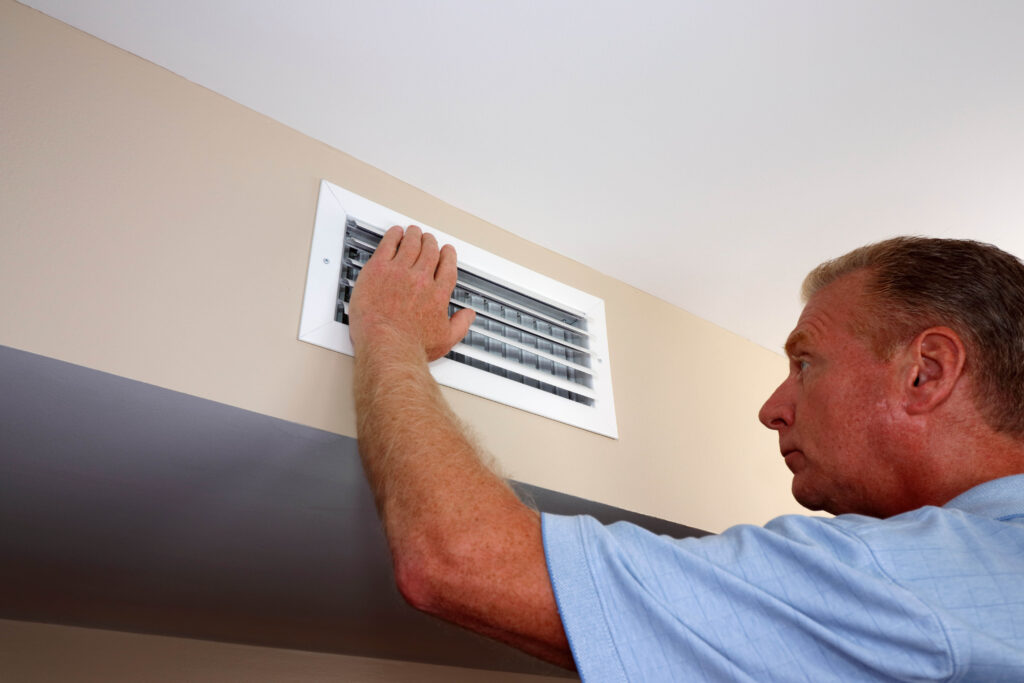- Indoor Air Quality (IAQ) Solutions
- IAQ Solution Benchmarks
- Included IAQ Services
- Frequently Asked Questions
- Get a Quote
Indoor Air Quality (IAQ) Solutions
Indoor air quality (IAQ) solutions are comprehensive strategies aimed at ensuring clean, healthy air in residential, commercial, and industrial buildings. These solutions address various factors, including airborne contaminants, humidity levels, ventilation, and temperature control. IAQ solutions involve installing air purification systems, such as HEPA filters, UV-C germicidal lamps, and ionizers, to remove pollutants, allergens, and pathogens from the air.

Humidifiers and dehumidifiers are used to regulate indoor humidity levels, preventing mold growth and enhancing comfort. Proper ventilation systems, including exhaust fans and fresh air intakes, ensure the circulation of fresh outdoor air while expelling stale indoor air. Regular maintenance of HVAC equipment and ductwork prevents the buildup of contaminants that can compromise IAQ.
Implementing IAQ solutions improves respiratory health, comfort, and overall well-being, creating a healthier and more productive indoor environment. These solutions are essential for maintaining high air quality standards and ensuring the safety and comfort of building occupants.
IAQ Solution Benchmarks
Ensuring optimal indoor air quality (IAQ) is crucial for maintaining a healthy and comfortable environment in any building. HVAC IAQ solutions involve several key service milestones to address and improve air quality. Starting with a comprehensive assessment and air quality testing, these solutions then move to customized system design and planning. The process includes installing advanced air purification systems, enhancing ventilation, and controlling humidity levels. Regular performance monitoring and ongoing evaluation ensure the continued effectiveness of these solutions, adapting to changing conditions and maintaining high air quality standards. Below is an overview of the major service milestones involved in HVAC IAQ solutions.

Major Service Benchmarks of HVAC Indoor Air Quality (IAQ) Solutions
- Initial Assessment and Air Quality Testing: This first step involves conducting a comprehensive assessment of the indoor air quality (IAQ) within the building. Technicians use advanced air quality monitors to measure levels of pollutants such as particulate matter, volatile organic compounds (VOCs), and carbon dioxide.
- System Design and Planning: Based on the assessment, a customized plan is developed to address identified air quality issues. This plan includes the selection and placement of air purification systems, ventilation enhancements, and humidity control measures.
- Installation of Air Purification Systems: Installing systems such as HEPA filters, UV-C germicidal lamps, and ionizers to remove pollutants, allergens, and pathogens from the air. These systems are integrated into the existing HVAC framework.
- Ventilation Improvements: Enhancing ventilation by installing or upgrading exhaust fans, fresh air intakes, and air handling units to ensure proper circulation of outdoor air and expulsion of stale indoor air.
- Humidity Control: Using humidifiers and dehumidifiers to maintain optimal humidity levels, preventing mold growth and improving overall comfort.
- Performance Monitoring and Maintenance: Regularly monitoring air quality and maintaining HVAC equipment to ensure continued effectiveness. This includes cleaning and replacing filters, checking system performance, and making necessary adjustments.
- Ongoing Evaluation and Adjustments: Continuously evaluating the system’s performance and making adjustments as needed to adapt to changing conditions and maintain high air quality standards.
Included IAQ Services
Maintaining excellent indoor air quality (IAQ) is essential for the health and comfort of building occupants. HVAC IAQ solutions encompass a range of services designed to identify and mitigate air quality issues. These services include comprehensive air quality testing, custom system design, and the installation of advanced air purification systems. Enhancing ventilation, controlling humidity, and conducting regular maintenance are also critical components. Continuous monitoring ensures that the IAQ remains optimal, adapting to changing conditions. Below is an overview of the key services involved in HVAC IAQ solutions.

Services in HVAC Indoor Air Quality (IAQ) Solutions
- Air Quality Testing: Assessing the levels of various pollutants and identifying sources of contamination.
- Custom System Design: Developing tailored solutions based on the specific needs of the building and its occupants.
- Air Purification: Installing systems such as HEPA filters, UV-C lamps, and ionizers.
- Ventilation Enhancements: Improving ventilation to ensure proper airflow and expulsion of contaminants.
- Humidity Control: Using humidifiers and dehumidifiers to maintain optimal humidity levels.
- Regular Maintenance: Conducting routine checks and maintenance to ensure system efficiency.
- Continuous Monitoring: Using sensors and monitoring tools to keep track of air quality and system performance.
What are common indoor air pollutants?
- Common pollutants include particulate matter, VOCs, carbon dioxide, mold spores, and allergens.
How often should air quality be tested?
- It’s recommended to test air quality at least once a year, with more frequent tests if there are known issues or significant changes in occupancy or building use.
What are the benefits of using HEPA filters?
- HEPA filters can capture up to 99.97% of airborne particles, significantly reducing allergens, dust, and other contaminants.
How do UV-C germicidal lamps work?
- UV-C lamps use ultraviolet light to kill or inactivate microorganisms like bacteria, viruses, and mold spores, improving air quality.
What is the ideal indoor humidity level?
- The ideal humidity level is between 30-50% to prevent mold growth and maintain comfort.
Can improving IAQ reduce energy costs?
- Yes, better IAQ can enhance HVAC system efficiency, potentially lowering energy costs by reducing the load on the system.
How can I tell if my indoor air quality is poor?
- Signs of poor IAQ include persistent odors, increased allergy or asthma symptoms, visible mold, and high humidity levels.
Get A Quote
Ensure a healthier and more comfortable indoor environment. Contact us today for a personalized quote on our comprehensive indoor air quality solution services!
